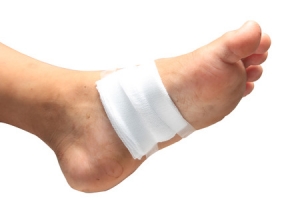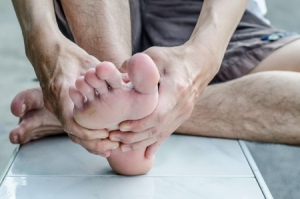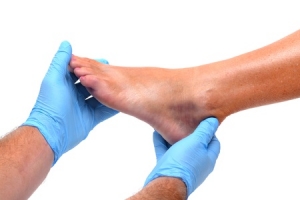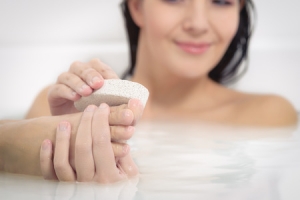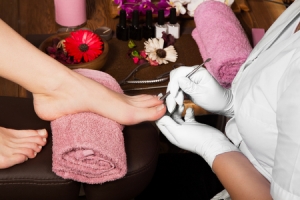Connect With Us
Blogs
Displaying items by tag: Diabetes
Do’s and Don’ts for Reducing Risk of Childhood Obesity
At Superior Foot & Ankle Care Center we treat many conditions that are made worse by the patient being overweight. The risk and severity of arthritis in the feet and ankles, metatarsalgia and flat feet, for example, are all increased by obesity. In addition, being obese increases the risk for diseases like diabetes and hypertension, which also have serious health consequences for your feet. September is National Childhood Obesity Awareness Month. Studies have shown that obese children tend to continue to be obese as adults. For that reason, it’s important to foster healthy lifestyle habits during childhood. Below are some do’s and don’ts to help your child maintain a healthy weight:
Do: strive to have your child spend at least 60 minutes a day being physically active. Encourage them to participate in a wide variety of activities to be sure they get exercise that is aerobic, muscle and bone strengthening. Not all activities have to be organized. Just playing in the yard children are likely to run, jump and climb which will give them all the types of exercise they need.
Don’t: force your child to be active if they complain of foot or ankle pain. If you suspect a podiatric problem is sidelining your child from being physically active, contact our Long Beach office (562-420-9800) for an appointment. Our podiatrists, Dr. Victoria Foley and Dr. Constance Omelas will examine your child’s feet to determine if there is an injury or other disorder that is causing them pain.
Don’t: allow unlimited amounts of time spent in front of a screen. If your child has full-time access to cell phone, television, computer and video games they are less likely to engage in physical activities.
Do: make changes in your family’s eating habits. Increase the number of fruits and vegetables in your menus, replace sugary drinks with water and have healthy snacks readily available. Involve your children in menu planning and grocery shopping and teach them how to make good food choices.
Do: set a regular bedtime for your child or teen that allows them to get enough sleep. Depending on your child’s age, they may need between 8 and 12 hours of sleep per night. Studies show that lack of sleep increases the risk of obesity.
Approximately 1 in 5 children today are obese. Working together, families and communities can help greatly reduce this number with lifestyle choices that will make for healthier children and, ultimately, healthier adults.
Diabetic Foot Ulcers Can be Prevented
Did you know that the leading cause of lower extremity amputations not caused by trauma is diabetes? And, foot ulcers precede 85 percent of these amputations. At Superior Foot & Ankle Care Center we want patients to know that diabetic foot ulcers can be prevented and our podiatrists, Dr. Victoria Foley and Dr. Constance Omelas will work with you to develop a care regimen and monitor your feet as a diabetic patient. Adhering to a schedule of regular podiatric checkups is an important step in protecting your feet if you have diabetes. Below are other areas where you can be proactive in preventing ulcers:
Healthy Foot Habits—in addition to regular podiatric exams, doing your own self-exams at home is also very important. Foot ulcers commonly form on the soles of the feet so be sure you check the bottom of your feet carefully (or have someone do it for you) and the rest of your feet as well on a daily basis. Report any redness, sores, blisters, rashes or cuts to the foot doctor asap. You should also wash your feet daily and dry completely. Use foot powder and change your socks whenever you notice that your feet feel damp. This will reduce the risk of bacterial and fungal conditions which can lead to infections and wounds.
Footwear—the shoes you wear can play a big part in preventing conditions that can lead to wounds. Choose styles that are made of soft, flexible material and have wide, roomy toe boxes. Shoes that squeeze toes together can increase the risk of ingrown toenails and blisters and hasten the progression of toe problems like hammertoes and bunions. Periodically run your hand around the inside of your shoes to make sure there are no small pebbles stuck inside or loose stitching that can rub against the skin and cause an irritation.
Lifestyle Choices—one of the most important steps you can take for preventing ulcers is keeping your blood sugar levels where they should be. Follow the dietary plan your doctor has given you and fill your menus with nutrient-rich foods that are low in sugar. Don’t smoke because it impedes circulation. Limit alcohol use as this has been linked with an increased risk of foot ulcers.
If you have diabetes and have additional questions about how to best care for your feet and prevent diabetic complications, contact our Long Beach office by calling: (562) 420-9800.
Men and Diabetes
Before we say goodbye to the month of June, there’s one more health observance that we at Superior Foot & Ankle Care Center want to acknowledge: Men’s Health Month. A significant amount of research has been done about men and one disease that is of particular interest to us as foot health care providers, and that is diabetes. Although men and women may have similar symptoms and treatment, studies have shown that overall how men respond to diagnosis and care of the disease is very different and not in a good way.
The First Step: Admitting There’s a Problem
For many men, even after they realize that something is not right with their feet they put off making an appointment to have their symptoms evaluated. The reason for this is that they are afraid of getting bad news. If you are a man (or someone who loves one) and have noticed any of the following symptoms in the feet: cuts that are slow to heal, loss of sensation in one or more parts of the feet or a burning, tingling feeling, swelling or anything else out of the ordinary, it’s important that you make an appointment at our Long Beach office and allow one of our podiatrists, Dr. Victoria Foley or Dr. Constance Omelas to examine your feet. Delaying seeking treatment will not make the symptoms go away and prompt treatment can greatly improve the outcome.
Get the Care You Need
Another significant research finding showed that in cases where men and women had equal access to health care for their diabetes, men were more likely to miss appointments and not get the treatment they needed. The good news about diabetes is that is highly controllable today. Many patients with diabetes continue to live full and active lives—if they keep their diabetes under control. The best ways to do this are:
- Schedule (and keep!) regular appointments with the podiatrist and other physicians managing your diabetic care.
- Follow dietary recommendations and medical treatments.
- Check your feet daily for changes that may indicate a problem.
- Wear shoes that fit properly and allow plenty of room in the toe box.
- Keep feet dry and avoid putting them in front of direct heat.
At Superior Foot & Ankle Care Center we can take the fear and mystery out of diabetes if you let us. If you have concerns about your feet (or you believe a man in your life does) contact us by calling: (562) 420-9800.
June is Older Americans Month
At Superior Foot & Ankle Care Center we know that foot care needs change as you age. This week we’d like to address some foot health care needs that are particularly important for our more senior patients in honor of Older Americans Month.
Work with Your Podiatrist—there are several foot ailments that are more likely to develop as you age, such as arthritis and certain nerve issues. Your feet may also be the first place that systemic disorders such as diabetes or circulatory dysfunction show up. For these reasons, it’s important to maintain a regular schedule of checkups with our podiatrists, Dr. Victoria Foley and Dr. Constance Omelas. This will enable the foot doctor to spot changes in your feet and also help you manage chronic foot issues and keep them from becoming debilitating.
Shoe Sense—good shoes are important at any age but for senior patients, the right shoe can prevent falls and keep foot disorders from worsening. Have your foot professionally measured at a quality shoe store. It is not unusual for your shoe size to increase as you get older. Buy shoes that have good arch and ankle support and a gripping tread on the bottom. Shoes with laces give a better fit than Velcro. For dress shoes, keep heels to no higher than 2 inches. Replace shoes when they become stretched out or damaged.
Develop a Daily Foot Care Regimen—wash your feet every day and dry completely. Check your feet for any changes in skin or nails, cuts, bruises, growths or any other unusual symptoms. Keep toenails trimmed straight across and not too short to avoid ingrown nails. Apply moisturizer or foot powder as needed.
Good Habits for Life—many of the lifestyle choices that are healthy for the rest of your body have a positive impact on your feet too. Don’t smoke—it impedes circulation. Exercise regularly to increase bone strength and maintain range of motion. Keep your weight down because extra pounds put more stress on joints and bones in your lower extremities.
Keeping your feet healthy during your senior years isn’t difficult. To learn more about how to ensure that your feet will enable you to live a long, active life, contact our Long Beach office by calling: (562) 420-9800.
Protecting Yourself with PAD
Peripheral arterial disease (or PAD) often affects patients that have diabetes. At Superior Foot & Ankle Care Center we always caution these patients to take extra care with their feet due to the serious one-two punch these diseases can deliver. PAD is a disease that results in poor circulation. Good blood flow is necessary for healing. Patients with diabetes often experience neuropathy or loss of sensation in their feet and toes. This means it can be difficult to perceive pain, heat or even itchy rashes—all of which may signal a situation that would result in an open sore or wound. Add PAD to that and you could end up with an ulcer or wound on your foot that will not heal. This, in turn, can lead to a dangerous infection, and, in the worst case scenario, possible amputation.
Simple Precautions
If you have diabetes you should already be on a regular schedule of checkups with our podiatrists, Dr. Victoria Foley and Dr. Constance Omelas in order to carefully monitor your condition. The foot doctor will also look for signs of PAD. In addition to having diabetes, other factors that increase your risk for PAD include:
- Being over age 50
- Smoking
- Sedentary lifestyle
- High cholesterol
- High blood pressure
- Family or personal history of PAD
With or without PAD it’s important to avoid putting your feet at risk of injury or infections. To this end, you should:
- Avoid walking barefoot. In public places, this will reduce your risk of coming in contact with fungi and bacteria that can cause infections like athlete’s foot and fungal toenails. At home, you will be far less likely to get a cut or puncture wound on the bottom of your foot if your feet are covered.
- Wear shoes that fit properly. Shoes that are too small can cause blisters or exacerbate conditions such as hammertoe and bunions. Periodically check the insides of your shoes to make sure there are no rough spots or loose stitching to cause friction against your skin.
- Keep skin soft and supple by applying a rich moisturizer to your feet. Avoid the area between your toes, however, to prevent an excessively moist environment where fungi can breed.
- Get in the habit of checking your feet regularly for any changes or abnormalities. If you spot anything unusual, contact our Long Beach office immediately to get it checked by calling: (562) 420-9800.
5 Ways to Take Better Care of Your Feet
At Superior Foot & Ankle Care Center we believe in being proactive when it comes to the health of your feet. In honor of Foot Health Awareness Month, we’d like to offer the following tips for taking care of your feet:
- Wear shoes that fit. This is one of, if not the single biggest steps you can take to prevent foot and ankle injuries and disorders. Some studies have shown that up to 90% of people are wearing shoes that are the wrong size! Shoes that are too narrow or tight in the toe box can encourage deformities such as bunions and hammertoes as well as increase the risk of ingrown toenails and fungal infections. Get your foot professionally measured at the shoe store. Shoe size can change as you age and during pregnancy.
- Get in the habit of doing self-exams on your feet. Changes in the skin or nails of your feet, as well as shape, size or color, can all be indicators of potential foot problems. Any differences in sensation (burning, numbness, tingling), swelling or abnormal growths should be reported to our podiatrists, Dr. Victoria Foley and Dr. Constance Omelas promptly. Early detection of a foot problem can mean a better outcome and less invasive treatment.
- Limit time going barefoot. Bare feet in public places are at a higher risk for coming in direct contact with fungi and bacteria that cause infections such as athlete’s foot and fungal toenails. Even at home, however, going barefoot increases your risk of puncture wounds and injuries.
- Don’t neglect foot hygiene. Basic daily care of your feet should include washing with soap and water (and drying completely) as well as applying foot powder or moisturizing lotion, depending on your individual needs. Don’t wear socks more than one day and alternate our shoe choice as well.
- Live a Healthy Lifestyle. You may not think about it but maintaining a healthy weight, exercising and getting regular checkups all contribute to the health and well being of your feet. Be sure that you monitor chronic diseases such as diabetes and arthritis and follow your physicians’ instructions for keeping this conditions under control.
If you have questions about how to best care for your feet, contact our Long Beach office by calling: (562) 420-9800.
3 Ways that Food Affects Your Feet
At Superior Foot & Ankle Care Center we know that the condition of your feet isn’t just about what goes on below your knees. Our podiatrists, Dr. Victoria M. Foley and Dr. Constance Ornelas believe that the health of the rest of your body plays a significant role in podiatric concerns. In honor of National Nutrition Month, we want to highlight the importance of proper eating and how it relates to your feet. Below are 3 ways that your diet can improve the health of your ankles and feet.
- Avoid Diabetes—diabetes, which afflicts over 30 million people in the U.S., affects your body’s ability to properly use or produce insulin resulting in high blood sugar levels. Diabetes reduces circulation and can cause neuropathy (loss of sensation) leaving your feet vulnerable to wounds and ulcers that can lead to infections and even possible amputation. The good news is you can prevent or significantly delay the onset of the most common form of this disease, Type 2 diabetes, with physical activity and modifications to your diet, including:
- Cutting way back on foods high in added sugar such as sodas and refined, processed foods
- Increasing the number of fruits, vegetables and whole-grain foods you consume every day
- Switching to healthier sources of fat such as olive and canola oil, nuts and avocados and avoiding saturated fats
- Prevent Gout Attacks and Inflammation—for patients who suffer from gout food is often what triggers an attack. Avoiding shellfish, red meat, beer, red wine, organ meats and heavy sauces can help you steer clear of this extremely painful joint inflammation which often happens in the big toe or ankle. Inflammation in, general, can be reduced by eating more berries, fish, and nuts high in omega 3 fatty acids, green vegetables, and olive oil, while steering clear of white sugar, fried food and refined flours.
- Decrease Your Risk of Foot Disorders—what do arthritis, plantar fasciitis, stress fractures and flat feet all have in common? The risk of developing one of these podiatric disorders as well as the severity of their symptoms are all increased by being overweight. There are many strategies for reducing and maintaining a healthy weight:
- Using smaller plates to automatically reduce portions
- Consulting a nutritionist or registered dietician to develop a healthy food plan
- Eat smaller portions more frequently instead of big meals
If you have questions about how changing your diet could impact a chronic foot condition contact our Long Beach office at 562-420-9800.
Holiday Shopping May Inflame Varicose Veins
Perhaps you never even noticed them before or maybe those unsightly veins were something you saw but didn’t think twice about because they weren’t bothering you in any way. During the holiday season, however, we at Superior Foot & Ankle Care Center often see an increase in the number of patients complaining about this disorder. Why? Standing for long periods of time—such as waiting on long lines to purchase your holiday gifts—puts extra pressure on veins and can result in pain and discomfort.
If you have varicose veins, you may notice that after a day at the mall your legs feel heavy and achy. The skin around the veins may be itchy or dry and the veins may actually throb or hurt. It’s not uncommon to have swelling in your feet, ankles or lower legs as well.
Getting Relief
If this occurs, it’s a good idea to make an appointment at our Venice office so that our podiatrists, Dr. Victoria Foley and Dr. Constance Omelas can examine your legs and feet. In some cases, varicose veins can signal a problem with your circulatory system. There are several conditions such as diabetes and peripheral vascular disease that are associated with blood flow issues. The doctor will want to rule out a more serious condition.
The treatment for your veins will depend on the source and the foot doctor will go over the options available and the best one for your particular situation. In some cases, the podiatrist will recommend minimally invasive surgery or laser therapy. Most often, however, conservative measures can be utilized to lessen the irritation to the veins. These include:
- Wearing compression stockings
- Elevating the legs, especially at the end of the day
- Avoiding sitting or standing for long periods of time; take breaks if your job requires hours at your desk or standing up
- A consistent exercise routine
- Weight loss if you are currently overweight as this puts additional strain on your veins
If you are concerned about varicose veins or have additional questions about this condition, contact us by calling: 562-420-9800.
Show Some Gratitude for Your Feet
It’s the season of Thanksgiving and here at Superior Foot & Ankle Care Center we think your feet deserve to be on the list of things that you’re thankful for! The 26 bones, 33 joints, 107 ligaments and 19 muscles in each of your feet work together in complex and amazing ways to enable you to do all the activities you enjoy. Why not show your feet some gratitude with one or more of these proactive podiatric health ideas:
Pay attention: Many times your feet are the starting place of diseases that affect your entire body such as diabetes, arthritis, circulatory and nerve problems. Get in the habit of inspecting your feet regularly and report any unusual changes to the foot doctor. Even more minor problems—ingrown toenails, warts, athlete’s foot—are more easily treated when caught in their earliest stages.
Do a shoe review: Are your shoes hurting your feet? Check to see that the shoes you wear have adequate arch and ankle support as well as cushioning for the sole. This will go a long way to preventing foot injuries and chronic conditions. Look for signs of wear and don’t continue to use shoes that are stretched out or have tears or loose stitching.
Have a spa day: pamper your feet with a relaxing foot soak. Then carefully trim toenails (straight across and not too short to avoid ingrown nails). Finish with a rich moisturizer massaged into your feet. If you prefer a salon pedicure just be sure to choose a place that follows proper sanitizing procedures for foot baths and tools to prevent fungal infections.
Watch your weight: being overweight puts excess strain and pressure on your feet and is a contributing factor in many foot problems. Maintaining a healthy weight will help reduce foot pain.
Get a checkup: When’s the last time you were in to our Long Beach office? Make an appointment by calling 562-420-9800 and let our podiatrists, Dr. Victoria Foley and Dr. Constance Omelas examine your feet. The foot doctor can alert you to any potential problems and make recommendations for ways that you can help keep your feet healthy.
Quit Smoking: 8 Ways to Fight Cravings
November is the month of the Great American Smokeout and here at Superior Foot & Ankle Care Center we want to alert patients to the fact the quitting smoking can improve foot health. While most people are aware that stopping smoking will greatly reduce the risk of cancer and heart disease, they may not realize the role that smoking plays in other aspects of their health, including their feet.
When you smoke, your blood vessels constrict and your circulation is reduced. Quitting will bring the following benefits:
- Faster healing of foot infections and injuries
- Reduced down time after podiatric surgeries
- Decreased risk of complications accompanying other diseases that affect the feet such as diabetes
- Lower risk of developing peripheral artery disease
Most people who resolve to quit will hit points where the physical or mental craving for a cigarette can be intense. Here are some suggestions from the American Cancer Society on how to tame cravings:
- At least in the beginning avoid being in places where people are smoking. Spend as much of your free time as possible in public places where smoking is prohibited—movie theaters, libraries, malls, church, restaurants and museums.
- Take good care of yourself. Get enough sleep, eat a well balanced diet and drink plenty of water.
- Cut yourself some slack. Smoking is an addiction and it’s natural to feel irritable, depressed, angry or other negative emotions. Plan ahead to have ways to deal with the stress: exercise, a hot bath or shower, positive imaging and mediation.
- Switch from 1 or 2 big meals a day to 4 to 6 small ones. This will help keep your blood sugar up, your energy level balanced and reduce the urge to smoke.
- If you miss the physical aspects of having a cigarette keep oral substitutes handy such as lollipops, carrot or celery sticks or hard candy. Have a pencil, smooth stone or paper clip at the ready to hold in your hand.
- Keep a photo of those you love with you at all times. Look at it when you are tempted to smoke to remind yourself of why you want to reduce your risk of cancer, heart disease and other health problems associated with smoking.
- Phone a friend or a smoking cessation hot line when you need extra support or someone to talk to as you battle.
- Celebrate milestones—one day, one week, one month—that you go without a cigarette.
Quitting smoking isn’t easy but the benefits to your feet (and the rest of your body) are well worth it. If you have questions about other conditions that affect your feet, contact our podiatrists, Dr. Victoria Foley and Dr. Constance Omelas at our Long Beach office by calling: 562-420-9800.

